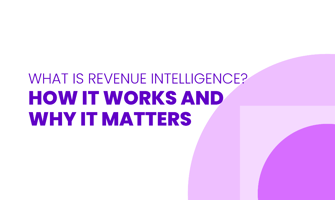Revenue attribution is the process of understanding which marketing, sales, or customer engagement...
Revenue Attribution Models Explained: Importance for Businesses
Understanding where your revenue comes from and which marketing efforts drive the most success is essential for any business. Revenue attribution models are tools that help businesses assign credit to specific touchpoints in the customer journey, allowing for more informed decisions. By analyzing these models, companies can determine which strategies deliver the best results and optimize their budgets accordingly.
Revenue attribution models range from simple, single-touch approaches to more advanced, data-driven solutions, each offering unique insights into customer behavior. This article will tell you about the different types of revenue attribution models, their significance for businesses, and how to choose the right one for your needs.
Learn how "revenue intelligence" works in our article: "What is Revenue Intelligence? How It Works and Why It Matters."
What Are Revenue Attribution Models?
Revenue attribution models are important for understanding how your business generates revenue. These models act as frameworks to assign credit to specific touchpoints or customer interactions before purchasing.
Each interaction clicking on an ad, opening an email, or visiting your website plays a role in the customer’s decision to buy. Revenue attribution models help you track these steps. The main purpose of these models is to measure how different marketing efforts contribute to revenue generation.
By connecting sales to specific marketing activities, you can see which strategies are truly driving results. For example, you might discover that social media ads bring in more revenue than email campaigns or that certain keywords in paid search lead to higher-value customers.
These models are also valuable for evaluating the effectiveness of your marketing efforts. They provide insights into which strategies bring the most value, allowing you to allocate your budget more wisely.
For example, if a model reveals that most of your revenue comes from repeat customers driven by email marketing, you can focus more resources on that channel to maximize growth.
![]()
Types of Revenue Attribution Models
1. Single-Touch Attribution Models
Single-touch attribution models are a way to measure how a business generates revenue by giving all the credit for a conversion to a single interaction in customer exploration.
In other words, only one touchpoint such as a first click, last click, or first ad a customer saw is recognized as the reason a customer made a purchase. This makes it one of the most straightforward ways to track what worked in your marketing efforts.
One major advantage of single-touch models is their simplicity. It’s easy to understand and use because you only focus on one point of interaction. For example:
If you use a "first-touch" model, the very first interaction like a customer clicking a social media ad—gets all the credit for their purchase.
In a "last-touch" model, the final step such as clicking a ‘Buy Now’ button receives complete credit.
This simplicity makes these models appealing for businesses with limited technical resources or for those just starting to look into revenue attribution.
However, single-touch models have significant limitations. Customer journeys today are rarely linear. Most customers interact with multiple channels like emails, ads, and website visits before deciding to buy.
By focusing on only one interaction, single-touch models often ignore the role of other touchpoints that contributed to the sale. This can lead to an incomplete or misleading understanding of what truly drives revenue.
For businesses with complex marketing strategies or longer sales cycles, single-touch models might oversimplify customer exploration, limiting their usefulness in creating data-driven decisions.
2. Multi-Touch Attribution Models
Multi-touch attribution models are important because they help you understand how different marketing efforts work together to influence your customers.
Unlike single-touch models that credit only one interaction, multi-touch attribution distributes credit across multiple touchpoints in customer exploration.
This means every step a customer takes whether they see an ad, read an email, or visit your website gets some recognition for its role in driving a purchase. The main idea behind multi-touch attribution is that customers rarely make decisions after just one interaction with your business.
For example, someone might first hear about your product through a social media post, then click on a paid ad, and finally, purchase after reading a follow-up email. A multi-touch model assigns value to each of these interactions instead of focusing on just one.
This approach offers several key benefits:
A complete view of the customer journey: By tracking multiple interactions, you can see how your marketing channels work together. For example, you might notice that a combination of paid ads and email campaigns drives more conversions than either one alone.
Better decision-making: When you know which touchpoints contribute the most to revenue, you can allocate your marketing budget more effectively. This helps you invest in the channels that deliver the best results.
Improved strategy optimization: Multi-touch attribution allows you to test and refine your strategies. If you see that certain touchpoints consistently perform well, you can focus on improving them further.
Imagine you’re running a business and trying to decide whether to spend more on social media ads or email campaigns.
A single-touch model might tell you that email campaigns are leading to the most sales, but a multi-touch model could reveal that social media ads are playing a huge role in bringing people to your website in the first place.
This extra layer of insight helps you understand the full impact of your marketing efforts. By using multi-touch attribution, you can avoid putting too much emphasis on just one part of the process.
Instead, you can focus on how everything works together to guide customers from their first interaction to their final purchase. This makes it an essential tool for any business looking for a more accurate and balanced way to measure marketing success.
3. Algorithmic or Data-Driven Attribution
Algorithmic or data-driven attribution models provide a powerful way to analyze and understand how your marketing efforts contribute to revenue.
Instead of relying on simple rules or assumptions, these models use actual data patterns to determine which touchpoints in the customer exploration deserve credit for a conversion. This makes them highly reliable for businesses looking to make data-backed decisions.
One popular approach within this category is Markov Chain attribution, which focuses on the sequence of interactions customers have with your marketing channels.
It works by calculating the probability of each touchpoint leading to a conversion, based on the paths customers take. For example, if a customer clicks on a paid ad, signs up for an email list, and then makes a purchase, the model analyzes the likelihood of each step influencing the final sale.
Here’s how algorithmic attribution models stand out:
They adapt to your data. These models don’t rely on fixed rules. Instead, they analyze customer behavior to reveal which channels or touchpoints are most effective.
They consider the entire exploration. Unlike simpler models, algorithmic attribution accounts for how all interactions work together, instead of focusing on just one or two steps.
They are dynamic. As customer behavior changes, these models adjust, ensuring your insights remain relevant.
By using methods like Markov Chains, businesses can find valuable insights about which marketing efforts are driving results. This allows you to allocate budgets more effectively and focus on strategies that truly work.
Importance of Revenue Attribution Models for Businesses
Revenue attribution models are important for helping businesses make smarter decisions based on their marketing efforts. By showing which channels and strategies bring in the most revenue, these models allow you to focus on what works and avoid wasting resources.
One major benefit of revenue attribution models is their ability to optimize your marketing spend. These models show you which campaigns, platforms, or touchpoints deliver the highest return on investment (ROI).
For example, if a particular ad campaign drives more sales than others, you can allocate more of your budget to that campaign. This ensures that every dollar you spend contributes effectively to your revenue.
Without this insight, you might continue investing in strategies that don’t perform well, which leads to wasted money and missed opportunities.
Here are a few ways these models help with optimizing marketing:
Pinpointing which marketing channels (like email, social media, or paid ads) generate the most revenue.
Identifying specific customer actions like clicking an ad or signing up for a newsletter that lead directly to purchases.
Helping you adjust your spending in real-time to focus on high-performing strategies.
Revenue attribution models also enable data-driven decision-making. Instead of relying on guesswork or gut feelings, you use actual data to guide your marketing strategies.
Tools like 180ops help businesses analyze and visualize data from multiple touchpoints, making it easier to identify which channels and strategies are driving revenue.
These models highlight the high-value touchpoints in a customer’s exploration, like the first time they visit your website or the moment they decide to make a purchase. By understanding these critical moments, you can refine your approach to target customers more effectively.
For example, let’s say your data shows that most customers interact with your blog before buying. You can invest more in creating valuable blog content to engage potential buyers.
You can also use this information to improve customer segmentation grouping customers based on their behaviors, preferences, or other traits. With better segmentation, you can create personalized campaigns that resonate more with your audience.
Lastly, revenue attribution models give you insights into customer behavior and preferences. They reveal how people look into your business, such as the steps they take before making a purchase.
This information helps you understand what your customers care about and how they interact with your brand. For example:
You might see that customers often watch a product demo video before buying. This means video content could play a critical role in their decision-making process.
Or you might notice that customers tend to interact with your brand multiple times through ads, emails, and your website before converting. This shows the importance of maintaining consistent messaging across all channels.
In short, revenue attribution models are powerful tools for improving your marketing efforts. They guide you to spend smarter, target better, and understand your customers more deeply. This leads to stronger results and a clearer path to long-term business growth.
![]()
Challenges in Implementing Revenue Attribution Models
Adopting revenue attribution models can be valuable for understanding how your marketing and sales efforts drive revenue. However, implementing these models comes with challenges that businesses need to address.
These obstacles often are caused by technical issues, resource limitations, and data complexities. One major challenge is integrating data from multiple sources. Your business likely collects information from websites, email campaigns, social media platforms, and offline channels.
To make accurate attributions, this data has to be combined in a way that is consistent and reliable. If the data is incomplete, duplicated, or formatted inconsistently, it can lead to incorrect conclusions.
Ensuring a clean and unified dataset often requires advanced tools and expertise, which can be difficult to manage, especially for smaller businesses.
Another common challenge is the technical complexity of setting up and maintaining attribution models. Advanced models, like multi-touch or algorithmic attribution, require detailed tracking systems, analytics platforms, and skilled personnel to configure and monitor them.
For businesses without in-house technical expertise, this can feel overwhelming. Even after the initial setup, ongoing maintenance is needed to adapt the model to changes in customer behavior or marketing strategies, which adds another layer of difficulty.
Additionally, the financial and time investments involved in implementation can discourage businesses from using advanced attribution models. High-quality analytics software often comes with a significant cost, and hiring or training staff adds to the expense.
For smaller companies or those with tight budgets, these investments might seem out of reach. Even when resources are available, the time required to implement and refine the model can delay seeing any benefits, which might make the effort feel less worthwhile.
These challenges can slow down or complicate the adoption of revenue attribution models, but understanding them is the first step toward finding effective solutions.
How to Choose the Right Attribution Model
To choose the right revenue attribution model, you need to understand how it aligns with your business goals and the resources available. The right model helps you make better decisions by showing which parts of your marketing efforts contribute most to revenue.
Start by defining your business objectives and identifying the key performance indicators (KPIs) that matter most to your success. For example, if your goal is to increase customer acquisition, focus on a model that highlights early touchpoints like ads or promotions.
On the other hand, if you want to drive long-term loyalty, look for an approach that tracks revenue over the entire customer exploration. Being clear about your objectives ensures that the model you choose prioritizes the right metrics.
Next, evaluate the quality and quantity of your data. A data-driven model, like an algorithmic approach, requires large amounts of accurate data to perform well. If your business has limited data or gaps in tracking customer touchpoints, simpler models like single-touch attribution might work better.
Also, consider whether your team has the tools and expertise to handle complex models or whether it’s better to use a straightforward method that fits within your current capabilities.
Here are some key aspects to consider when matching your needs to the right model:
Model complexity: How advanced is the model, and can your team manage it?
Data requirements: Does the model need more data than you currently collect?
Customer exploration length: Does the model work well for short or long sales cycles?
Cost: Are the software and resources needed within your budget?
Finally, think about accuracy and interpretability. While advanced models like algorithmic attribution can provide precise insights, they might be harder to understand and explain.
A model that is easier to interpret, such as multi-touch attribution, allows you to act on insights quickly. Balance the need for detailed accuracy with the practical value of making decisions based on the results.
By carefully considering your goals, resources, and data, you can identify a revenue attribution model that fits your business. This choice will help you track performance more effectively and make smarter, data-backed decisions.
Conclusion
Revenue attribution models provide valuable insights into the effectiveness of marketing and sales strategies, helping businesses make data-driven decisions.
By understanding and implementing these models, companies can allocate resources more effectively, improve ROI, and enhance overall performance.
Embracing the right attribution model for your business ensures you’re investing in strategies that deliver real results. As customer journeys grow more complex, leveraging these tools becomes increasingly important for sustainable growth.
FAQ
1. What is a revenue attribution model?
A revenue attribution model is a framework that helps businesses assign credit to specific customer touchpoints in their journey. It shows how marketing and sales efforts contribute to revenue, enabling better resource allocation and strategy optimization.
2. Why are revenue attribution models important for businesses?
Revenue attribution models help businesses:
Identify which marketing channels drive the most revenue.
Optimize marketing spend for higher ROI.
Align sales and marketing efforts for better results.
3. What are the main types of revenue attribution models?
The main types include:
Single-Touch Models (First-Touch, Last-Touch).
Multi-Touch Models (Linear, Time-Decay, Position-Based).
Data-Driven or Algorithmic Models, use advanced analytics for more precise credit assignments.
4. How can businesses choose the right revenue attribution model?
Businesses can choose the right model by analyzing their customer journey complexity, defining goals (e.g., lead generation or retention), and evaluating available tools. Aligning the model with marketing and sales objectives is also key.
5. What challenges do businesses face with revenue attribution models?
Challenges include:
Integrating data from multiple touchpoints.
Ensuring data quality for accurate analysis.
Balancing simplicity and precision when selecting a model.
Adapting models to changing customer behaviors and market conditions.




